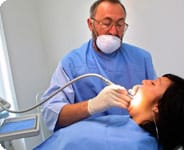There is no simple and effective treatment for osteonecrosis of the jaw. The painful exposed jaw bone can persist for years in many cases, and most experts recommend treatment with antibiotic and preventative actions to avoid jaw infection.
The best preventative action for treatment of jaw necrosis is to avoid dental surgery, tooth extraction or other procedures which could irritate or cause the condition to become symptomatic and infected.
Studies have shown that osteonecrosis of the jaw may be caused as a side effect of Fosamax and other bisphosphonate medications.
If dentists and users of the medication had been made aware of the jaw side effects of Fosamax, they could have avoided dental treatments that may aggravate the condition.
Saiontz and Kirk previously pursued Fosamax lawsuits against the drug manufacturer for failing to warn patients and the medical community about the known risks of jaw problems with their medication. Settlements have resolved the litigation and new cases are no longer being reviewed.
JAW NECROSIS TREATMENT
Treatment for osteonecrosis of the jaw only has a minimal effect on the symptoms and problems caused by the dead jaw condition. However, medications are often used to avoid jaw infection and further complications from the condition.
Some medical treatments which may be recommended include:
- Antibiotic Therapy
- Mouth Rinses
- Hyperbaric Oxygen Therapy
- Surgery to Remove Portions of Exposed Jaw Bone in the Mouth
PRECAUTIONS FOR OSTEONECROSIS AND TREATMENT FOR EXPOSED JAW BONE
For individuals who have been diagnosed with osteonecrosis of the jaw, the management of the condition will often involve the following recommendations:
- Consult with an oral surgeon
- Avoid oral surgery to prevent further injury
- Remove the sharp edges of the exposed jawbone to reduce trauma to surrounding areas of the mouth
- Use removable appliance to cover and protect exposed bone
- Use of antibiotic therapy to prevent infection and reduce pain
- Frequent dental visits if symptoms are present
- Adjustment of dentures to minimize trauma or irritation to the mouth
- Avoid dental implants, as they may result in further osteonecrosis
OSTEONECROSIS OF THE JAW TREATMENT MEDICATIONS
Antibiotic therapy is usually recomended for treatment of osteonecrosis of the jaw. Medications which may be prescribed include:
- Penicillin or Amoxicillin
- Clindamycin
- Vibramycin
- Erythromycin Ethylsuccinate
LINK BETWEEN FOSAMAX AND JAW NECROSIS
The use of Fosamax can lead to a significantly increased risk of osteonecrosis of the jaw. Therefore, if you have been taking Fosamax, it has been recommended that a specialist be consulted before undergoing even the most routine oral surgery. A thorough oral examination should be performed before any dental procedure to avoid exacerbation of the condition.
Unfortunately, the effects of osteonecrosis of the jaw are irreversible. Therefore, stopping the medication does not reverse the condition once symptoms of osteonecrosis are present. Given the long half life of Fosamax, after taking the medication for a long period of time, there is no data to suggest that stopping the medication will reduce the risk of osteonecrosis of the jaw.
Studies have also suggested that Fosamax side effects may lead to decay or death of other bones, including the hip, knee or shoulder. The lack of blood flow to the bones may lead to avascular necrosis or osteonecrosis of the hip, knee or shoulder, in addition to decay of the jaw bone.

